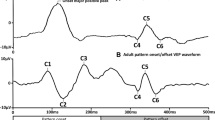Abstract
68 infants and children with proven tumours along the visual pathway visually evoked potentials with pattern reversal and flash were investigated. Subdivided in 5 locational groups (orbital, optic nerve, chiasmatic, retrochiasmatic and occipital lobe) best results were obtained by stimulation with pattern reversal using variable checksizes (91.2%) versus 61.8% by using flash evoked responses. Furthermore, using patterned stimuli not only latency shifts are best detected but also hints for visual function correlating to visual acuity could be given also in nonverbal or disabled children. For long term follow-up studies in known space-occupying lesions along the visual pathway, the use of pattern VEP is extraordinary because of its high sensitivity and complete harmlessness. Pattern VEP are even more sensitive than visual acuity testing in cooperative patients. The close interdisciplinary follow-up controls in these children between pediatric neurophysiologists and neurosurgeons are, therefore, strongly recommended.
Similar content being viewed by others
References
Albright AL, RJ Sclabassi: Cavitron ultrasonic surgical aspirator and visual evoked potential monitoring for chiasmal gliomas in children. J Neurosurg 63 (1985) 138–140
Bodis-Wollner I, SP Diamond: The measurement of spatial contrast sensitivity in cases of blurred vision associated with cerebral lesions. Brain 99 (1976) 695–710
Camacho LM, W Wenzel, J Aschoff: Klinische Anwendung der visuell evozierten Potentiale zur Untersuchung von chiasmatischen und postchiasmatischen Läsionen. Arch Psychiatr Nervenkr 230 (1981) 243–256
Cedzich C, J Schramm, R Fahlbusch: Are flash evoked visual potentials useful for intraoperative monitoring of visual pathway function? Neurosurg 21 (1987) 709–715
Costa e Silva J, A Wang, L Symon: The application of flash visual evoked potentials during operation on the anterior visual pathways. Neurol Res 7 (1985) 11–16
Dobson V, DY Teller: Visual acuity in infants: A review and comparison of behavioral and electrophysiological studies. Vision Res 18 (1978) 1469–1483
Feinsod M, JB Selhorst, WF Hoyt, CHB Wilson: Monitoring optic nerve function during craniotomy. J Neurosurg 44 (1976) 29–31
Frisén L: The neurology of visual acuity. Brain 103 (1980) 639–670
Frisén L, M Frisén: Micropsia and visual acuity in macular edema. A study of the neuro-retinal basis of visual acuity. A. v. Graefes Arch Clin Exp Ophthal 210 (1979) 69–77
Halliday AM, E Halliday, A Kriss, WJ Mc Donald, J Mushin: The pattern evoked potential in compression of the anterior visual pathways. Brain 99 (1976) 357–374
Harms DW, B Frauenknecht, D Wenzel: Frühsymptome kindlicher Tumoren des zentralen Nervensystems. Prädiat Prax 34 (1986/87) 619–626
Hoyt CS, BL Nickel, FA Billson: Ophthalmological examination of the infant. Developmental aspects. Surv Ophthalmol 26 (1982) 177–189
Kennedy HB, RJS Smith: Eye signs in craniopharyngeoma. Brit J Ophthal 59 (1975) 689–695
Oxenhandler DC, MP Sayers: The dilemma of childhood optic gliomas. J Neurosurg 48 (1978) 34–41
Packer RJ, PJ Saving, LT Bilaniuk, RA Zimmermann, NJ Schatz, JG Rosenstock, DS Nelson, PD Jarrett, DA Bruce, L Schut: Chiasmatic gliomas of childhood. A reappraisal of natural history and effectiveness of cranial irradiation. Childs Brain 10 (1983) 393–403
Skalka HW: Comparison of Snellen acuity, VER acuity, and Arden grating scores in macular and optic nerve diseases. Brit J Ophthal 64 (1980) 24–29
Sokol S: Measurement of infant visual acuity from pattern reversal evoked potentials. Vision Res 18 (1978) 33–39
Teller DY: Measurement of visual acuity in human and monkey infants: The interface between laboratory and clinic. Behav Brain Res 10 (1983) 15–23
Wenzel D, D Harms, U Brandl, M Klinger, F Albert: Electrophysiological diagnosis and follow-up controls in cases of tumours of the optic chiasm. In:Voth D, P Gutjahr, C Langmaid: (eds): Tumours of the central nervous system in infancy and childhood. Springer Verlag Berlin—Heidelberg 1982
Wenzel D: Die Entwicklung des Sehens beim Säugling und Kleinkind. In: Stehr K, U Mayer, D Harms (Hrsg.): Erkrankungen der Augen im Kindesalter. perimed Fachbuch-Verlag, Erlangen 1987
Wilson WB, WM Kirsch, H Neville, J Stears, M Feinsod, RAW Lehmann: Monitorring of visual function during parasellar surgery. Surg Neurol 5 (1976) 323–329
Author information
Authors and Affiliations
Rights and permissions
About this article
Cite this article
Wenzel, D., Brandl, U., Beck, JD. et al. Visual evoked potentials in tumors from orbita to occipital lobe in childhood. Neurosurg. Rev. 11, 279–286 (1988). https://doi.org/10.1007/BF01741423
Received:
Accepted:
Issue Date:
DOI: https://doi.org/10.1007/BF01741423




